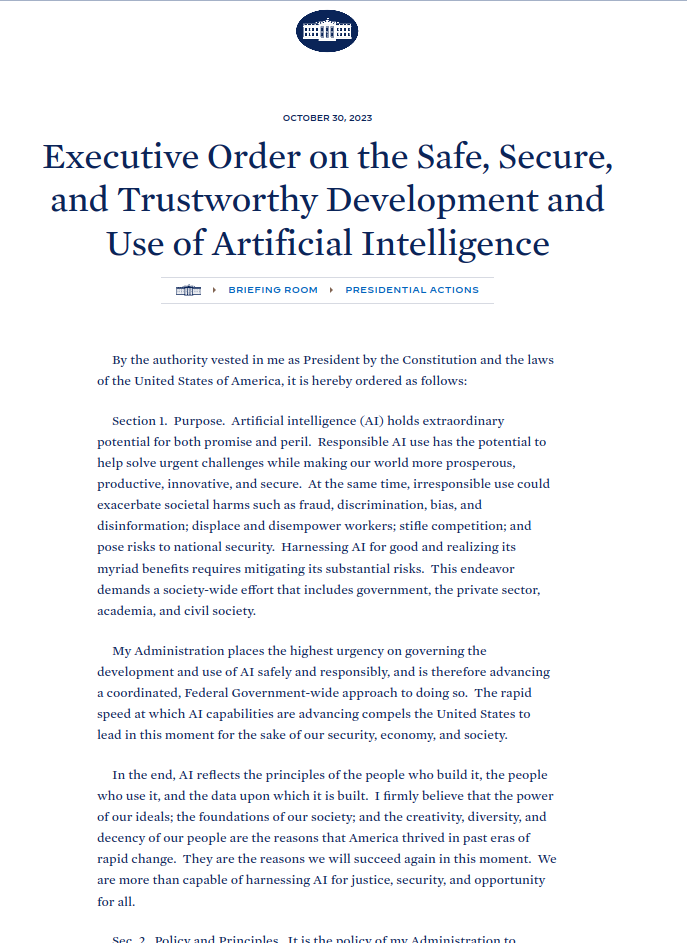Emerging Trends in Responsible AI and Synthetic DNA in the USA
Image created by DALL·E, generated on 22.Feb.2024 based on user-provided prompts.
Responsible-AI is an unavoidable topic when we talk about advancements in biotechnology today. The enhanced information management capability THAT AI OFFERS, along with the already available low-cost genetic editing tools, simply accelerates R&D in an incredible way. And it reduces entry barriers, which arouses as much interest as concern.
In this article, we TALK about the INTERSECTION of AI and synthetic DNA from the responsible-Ai perspective. More specifically, we provide a summary of the framework of actions that is taking place in the USA along with an executive order from the White House, to prevent biotechnological risks associated with the misuse of AI tools.
IMPACTFUL USES FOR RESPONSIBLE-AI
Bioengineering and synthetic biology.
AI can facilitate the efficient and economical creation of new biological systems.
AI has a role in facilitating de novo biological design, which involves creating new biological systems and components. By means of accelerating the design process, making it more efficient and less costly. However it poses security risks by the ability to design pathogens or harmful biological agents as well.
Closed-Loop Autonomous Biological Research.
AI-powered systems can self-experiment in closed environments, augmenting the overall capacity to accelerate bioengineering.
The focus here is on the development of closed-loop systems that integrate AI with biological research to enable autonomous experimentation. This approach can significantly speed up research, leading to rapid advancements in biotechnology. Nonetheless, this points out the dual-use nature of such technologies, where they could be repurposed for harmful activities.
Use of generative AI to Generate Biological Information.
LLMs can be used to explore, design and identify biological agents using DNA.
Large language models (LLMs) in biology may have an important role particularly in understanding and generating biological data. LLMs' ability to process vast amounts of data can uncover new insights in biology and medicine. However, the potential misuse of LLMs to generate hazardous biological information or facilitate bioterrorism is a significant concern. The ERBC report advocates for careful monitoring and ethical use of LLMs in biological research.
AN EXECUTIVE ORDER FROM THE WHITE HOUSE
In October 2023, the White House issued an executive order that calls for the development and implementation of AI in a manner that prioritizes public health and safety, including the prevention of biotechnological risks. The order charges multiple agencies – including NIST – with producing guidelines and taking other actions to advance the safe, secure, and trustworthy development and use of Artificial Intelligence (AI). The order is of urgent application and binds the entire Life Sciences sector.
“All agencies that fund life-sciences research shall, as appropriate and consistent with applicable law, establish that, as a requirement of funding, synthetic nucleic acid procurement is conducted through providers or manufacturers that adhere to the framework, such as through an attestation from the provider or manufacturer.”
STATE OF THE ART
January, 2023. NISTS’ Artificial Intelligence Risk Management Framework (AI RMF 1.0). WEBSITE
October, 2023. Executive Order on the Safe, Secure, and Trustworthy Development and Use of Artificial Intelligence. WHITE HOUSE
November, 2023. Engineering Biology Research Consortium (EBRC) white paper. “SECURITY CONSIDERATIONS AT THE INTERSECTION OF ENGINEERING BIOLOGY AND ARTIFICIAL INTELLIGENCE”. WEBSITE
February, 2024. NIST & EBRC partnerING on Safety Tools for Synthetic Biology to Defend Against Potential Misuse of AI. PRESS NOTE
NIST and EBRC partnered to research the impact of Synthetic Nucleic Acid Sequencing
THE ENGINERRING BIOLOGY RESEARCH CONSORTIUM (ERBC) had made a call for international collaboration to address the security challenges at the intersection of engineering biology and AI. ITS white paper proposes the establishment of an international forum to facilitate dialogue, share best practices, and develop standardized guidelines.
THEN, In order to comply with the Executive Order, THE NATIONAL INSTITUTE OF SCIENCE AND TECHNOLOGY (NIST) has partnered with the EBRC for a two-year research project aimed at developing screening and safety tools for the synthesis of nucleic acids, in response to potential risks associated with the misuse of artificial intelligence (AI) in this field. The initiative seeks to balance the significant benefits of synthetic biology innovations, such as new drugs and therapies, against potential threats to public safety, environmental security, and national security, by engaging with various stakeholders to create necessary safeguards and policies.
NISTS’S DUE DATES UNDER Executive Order 14110. SOURCE



